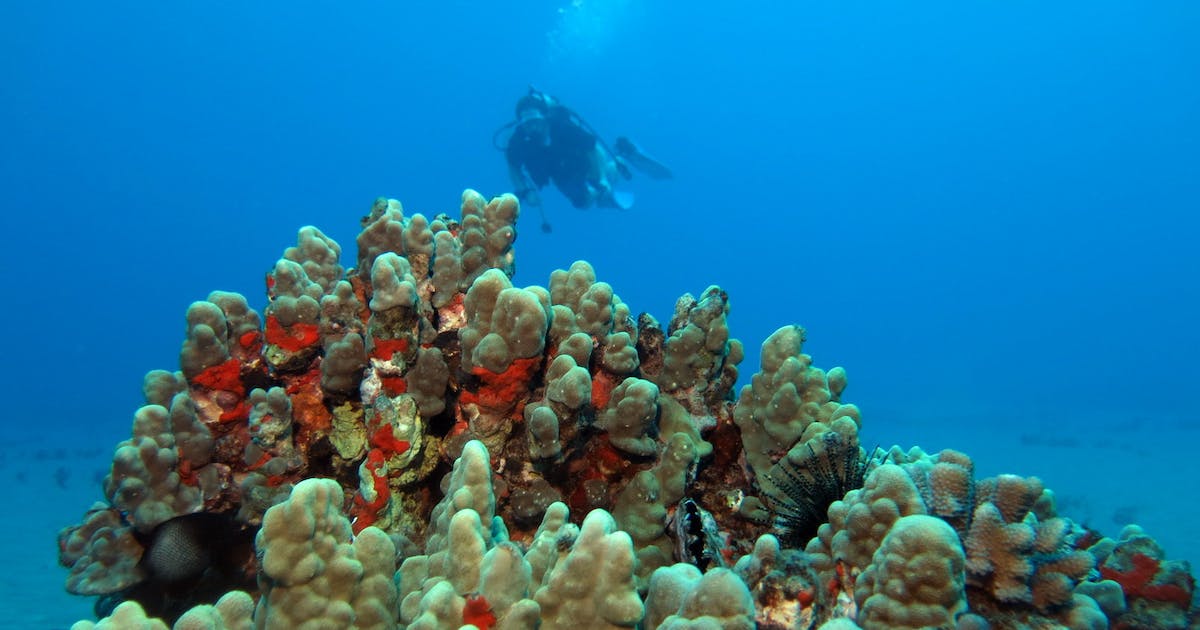A deep-sea discovery is giving scientists hope for the future of coral reefs.
The story: On a recent underwater expedition, researchers discovered one of the world’s largest intact coral reefs at depths of 30 to 70 meters (98 to 230 feet), reports Rick Noack for The Washington Post. Found off the coast of Tahiti, this deep-sea reef stretches nearly 3.2 kilometers (2 miles) and is in “pristine” condition, despite a severe bleaching episode in these waters in 2019, which affected two-thirds of Tahiti’s reefs. Scientists believe it could offer clues to how other reefs might survive the impacts of climate change.
The big picture: “The fact that we are finding a very healthy and pristine coral reef at depths of 30 to 70 meters [98 to 230 feet] is quite unusual,” Julian Barbière, a marine biologist, told The Washington Post — adding that only 20 percent of the world’s seabed has been mapped in high resolution. “There could be all those reefs out there that have not been mapped or studied.”
As scientists explore the deep sea, they continue to uncover new species and reefs. For example, in 2020, a team of researchers — including Conservation International’s Daniel Wagner — discovered three new species of black coral in the North Pacific — each more than 670 meters (2,221 feet) below the ocean’s surface. According to the researchers, these reefs could hold clues to maintaining healthy coral in the face of climate change. However, these reefs face looming threats from deep-sea mining and overfishing, which could decimate species on the seafloor.
- FURTHER READING: In the high seas, scientists uncover a ‘vortex of life’
A volcanic eruption reveals the inequities of climate change.
The story: Tsunamis like the one unleashed in the wake of Tonga’s volcanic eruption could become more frequent and severe as climate change accelerates – hurting island nations the most, report Kanupriya Kapoor and Gloria Dickie for Reuters.
The rapidly warming waters surrounding Tonga are rising by 6 millimeters (0.2 inches) per year — nearly twice as fast as the rest of the world — potentially exacerbating the impact of tsunamis and hurricanes.
The big picture: Pacific Island nations are among the most vulnerable to climate change, yet they only account for 0.03 percent of global emissions. And natural disasters are not the only ways in which these countries are impacted. A recent study led by Conservation International found that ocean warming will alter the habitats of tuna outside of Pacific Island nations’ waters, with the potential to reduce the average tuna catch by a staggering 20 percent in this region.
“This is a climate justice issue,” Johann Bell, a Conservation International scientists and the study’s lead author, told Conservation International. “Pacific Island states charge access fees to other countries that catch tuna in their jurisdictions. But as the tuna move progressively to high-seas areas the revenues will decline because less fishing will occur in their waters — and tuna-dependent economies will suffer.”
Seed-eating species are migrating to new ecosystems, but what happens to the plants they leave behind?
The story: Birds and small mammals are critical to dispersing and planting seeds. But as climate change accelerates, these creatures are migrating to new ecosystems that better suit their needs, leaving plants without a way to spread their seeds, reports Andrea Thompson for Scientific American. According to a new study, biodiversity loss and climate change have had the greatest impact on seed-dispersal in North America and Europe.
The big picture: “We’re trying to understand, when we lose biodiversity, what does that mean for the ecosystems that those species are lost from?” Evan Fricke, a co-author of the new study, told Scientific American.
Birds and small mammals are ecosystem engineers — species that are critical to maintaining a healthy habitat for plants and wildlife in a specific area. Without these types of species, an entire ecosystem can be thrown out of balance, impacting food chains, plant growth and freshwater availability.
Kiley Price is the staff writer and news editor at Conservation International. Want to read more stories like this? Sign up for email updates here. Donate to Conservation International here.
Cover image: A coral reef in Hawaiʻi (© Conservation International/Edgardo Ochoa)
Further reading:

